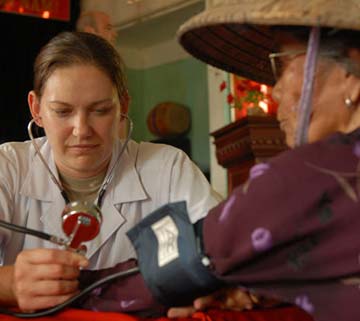Death and Dying, Lost in Translation
CA – Language barriers top the list of challenges doctors face with end-of-life conversations with patients from different ethnic backgrounds. It’s never easy for doctors to talk to their patients about death, but it’s especially hard when they don’t speak the same language. In fact, language differences top the list of barriers doctors encounter when discussing end-of-life issues with patients, according to a study published today in the journal PLoS One.
The nation is growing older and more ethnically diverse over time, according toUnited States Census Bureau statistics, which means more and more medical resources will be devoted to end-of-life care. Meanwhile, non-white patients are more likely to undergo intense, often useless treatments in their final years, and are less likely to go into hospice care—all while incurring higher end-of-life costs.
That’s a problem that better communication could ease, argues a team of researchers from the Stanford University School of Medicine and the Veterans Administration’s Palo Alto hospital. But until now, no one really knew what stood in the way of doctors talking with their patients about planning for their final days, especially when those patients were from different ethnic backgrounds.
Now, led by Stanford clinical professor and V.A. doctor Vyjeyanthi Periyakoil, the team reports the results of a study aimed at probing the stumbling blocks. The researchers sent surveys to 1,234 doctors completing their training at either Stanford or the V.A. More than 1,000 of those doctors responded to the survey’s three questions: Had they encountered barriers to end-of-life conversations? How challenging were the conversations with patients from ethnic backgrounds different from their own? What were the top three barriers to discussing end-of-life issues with those from different ethnic backgrounds?
About five in six doctors reported having had significant difficulties talking about death and dying with patients from different ethnicities, and as a group they cited language barriers as the top reason. “Medical jargon is often difficult to translate into other languages (as equivalent words may not exist) and and approximate translations do not convey the true meaning and may lead to misunderstandings and miscommunication,” Periyakoil and her team write.
Doctors also cited families’ religious and cultural beliefs as barriers. For example, doctors reported “religious cultural values that may lead people to prefer life-sustaining treatments that we may see as futile,” “hoping for a religious miracle,” and “not understanding which topics might be taboo” as obstacles to communication. Different norms concerning how much to tell a patient, health literacy, and distrust in doctors’ attention rounded out the barriers that doctors listed.
Photo: US Army / Flickr
Originally published by Pacific Standard, author Nathan Collins.


Leave a Comment
You must be logged in to post a comment.